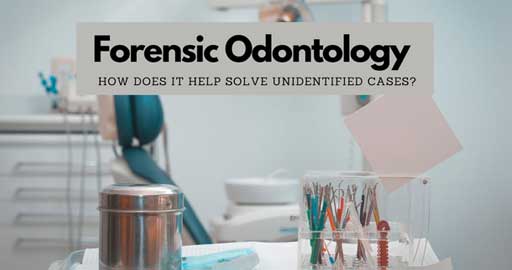
What is Forensic Odontology and how does help Solve Unidentified Cases?
Table of Contents
Forensic odontology, often referred to as forensic dentistry, is a specialized branch of forensic science that plays a crucial role in identifying individuals in cases where traditional methods may not suffice.
By analyzing dental records, bite marks, and oral evidence, forensic odontologists provide valuable insights to law enforcement agencies, medical examiners, and forensic investigators. This article explores the world of forensic odontology, its methodologies, and its significance in solving unidentified cases.
The Role of Forensic Odontology
Forensic odontology serves a unique purpose in the field of forensic science. While other disciplines such as fingerprint analysis and DNA profiling primarily focus on physical evidence, forensic odontologists specialize in examining the dental structures and oral tissues of human remains. This specialization is valuable for a variety of reasons:
- Human Identification: One of the primary applications of forensic odontology is the identification of human remains. In cases where other identifying factors like fingerprints or DNA are unavailable or compromised, dental records can serve as a reliable source of identification.
- Mass Disasters: In large-scale disasters, such as plane crashes, natural disasters, or terrorist attacks, identifying victims can be challenging. Forensic odontologists play a crucial role in sorting through dental records and analyzing dental remains to establish the identity of victims.
- Bite Mark Analysis: Forensic odontologists are often called upon to analyze bite marks left on victims or suspects. This analysis can provide evidence in criminal investigations, such as cases of assault, sexual assault etc
- Age Estimation: Determining the age of an individual can be essential in both forensic investigations and identifying unknown remains. Dental age estimation techniques can provide valuable insights into the age of an individual at the time of their death.
- Bite Mark Comparison: When bite marks are found on a victim’s body, forensic odontologists can compare these marks to the dental impressions of potential suspects. This comparison can be crucial in establishing a suspect’s involvement in a crime.
Methodologies in Forensic Odontology
Forensic odontology employs several methodologies to accomplish its objectives, which include:
- Dental Records: Dental records are comprehensive files maintained by dentists that contain detailed information about a person’s dental health. These records include X-rays, photographs, treatment plans, and other relevant data. When a person is missing or unidentified, forensic odontologists compare these records with the dental remains to establish a positive identification.
- Post-Mortem Examinations: When human remains are discovered, forensic odontologists perform post-mortem examinations to assess the condition of the dental structures. This involves documenting dental anomalies, restorations, missing teeth, and unique dental features that can aid in identification.
- Age Estimation: Forensic odontologists use various methods to estimate the age of an individual based on dental development and tooth eruption patterns. This information can help narrow down the pool of potential identities for unidentified individuals.
Challenges and Limitations
While forensic odontology is a powerful tool in forensic science, it also faces certain challenges and limitations:
- Subjectivity: Some aspects of forensic odontology, such as bite mark analysis, are subjective and can be influenced by the examiner’s judgment. This subjectivity has led to controversies and errors in the past.
- Lack of Standardization: Unlike some other forensic disciplines, forensic odontology lacks strict standardization in methods and protocols. This can lead to inconsistencies in findings and interpretations.
- Human Error: As with any field, human error can occur in dental identification and bite mark analysis. Misinterpretations or miscommunications between forensic odontologists and other investigators can impact the accuracy of results.
- Advances in DNA Technology: The advent of advanced DNA profiling techniques has somewhat overshadowed the role of forensic odontology in recent years. In cases with suitable DNA evidence, DNA analysis may take precedence over dental identification.
- Limited Dental Records: In some cases, individuals may not have comprehensive dental records, making identification through forensic odontology challenging. This is more common in cases involving marginalized or transient populations.
Recent Developments and Future Prospects
Despite its challenges, forensic odontology continues to evolve with advancements in technology and research. Some recent developments and future prospects include:
- 3D Imaging: Three-dimensional imaging techniques, such as cone-beam computed tomography (CBCT) and 3D scanning, have enhanced the precision and accuracy of dental identification and bite mark analysis.
- Digital Dental Records: The transition from paper-based dental records to digital records has streamlined the retrieval and comparison of dental information, making the identification process more efficient.
- Bite Mark Analysis Software: The development of specialized software for bite mark analysis has the potential to reduce subjectivity and improve the reliability of bite mark evidence in criminal cases.
- Interdisciplinary Collaboration: Forensic odontologists increasingly collaborate with other forensic experts, such as DNA analysts and anthropologists, to integrate multiple lines of evidence for more accurate identifications.
- Standardization Efforts: Efforts are being made to standardize methods and protocols in forensic odontology, reducing the risk of inconsistencies and errors.
Conclusion
Forensic odontology is a specialized field of forensic science that plays a vital role in identifying individuals in cases where traditional methods may fall short. By examining dental records, analyzing bite marks, and estimating the age of dental remains, forensic odontologists contribute significantly to solving unidentified cases, especially in mass disasters, cold cases, and criminal investigations.
Despite its challenges, ongoing developments in technology and standardization efforts continue to enhance the accuracy and reliability of forensic odontology, ensuring its continued relevance in the field of forensic science.
By: Dr. Nayanika Batra
Leave a Reply
Leave a Reply
Explore More Similar Posts
Explore More Blogs


Leave a Reply